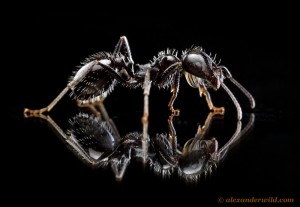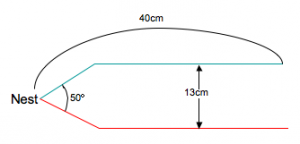
Messor pergandei.
http://www.alexanderwild.com/Ants/Taxonomic-List-of-Ant-Genera/Messor/i-4m4cgND/A
Though they may be little, ants use a ton of cool different ways to effectively and efficiently gather food. Column foraging, the name of one of these strategies, is worth noting as one of the most impressive. According to an article published in this month’s issue of the Journal of Comparative Physiology A, several species of harvesting ants use this neat column foraging strategy. But how does this type of foraging work exactly? And so what?
Column foraging can be thought of as an organized, single-file, mass exit of the nest in a search for food. A few leader ants leave the nest and travel along in a line, or “column”. They are followed by several thousands of worker ants who follow the column for anywhere from 3 to 40 meters. At the end of the column, the ants set out across what is called a “foraging fan” where they forage on their own and return to the column after they have found food. How do the ants know to follow along this column? Researchers believe that the leader ants most likely lay down a chemical pheromone trail as they go to guide the rest of their comrades.
But what is the point of establishing the columns if the ants ultimately disperse and forage on their own anyway? Previous researchers have hypothesized that the columns exist in order to direct the worker ants to separate food sites so that they avoid running into neighboring ant colonies. This is important because we know that aggression can occur when columns from neighboring ant colonies intersect. To find proof for this hypothesis, the researchers examined column foraging behavior in two closely related species of harvesting ants: Messor pergandei and Messor andrei.
These ant species have 4 chemical secreting glands—previous research tells us that the important chemical for laying down the column is present in the poison gland. Researchers performed experiments both in the lab, and in the natural habitat of the ants, with extracts from the poison gland. What they did was set up experiments in which they gave groups of ants of each species the option of two trails: the first trail was a conspecific (of the same species) poison gland extract and the second trail was also poison gland extract but it was heterospecific (with extracts from glands of the other species).

Schematic representation of experimental design. Blue and red lines represent two options of trails. Beginning at the nest, two separate columns diverge for 8cm at 50 degrees and continue parallel at 13cm apart for a total of 40 cm.
As expected, the ants followed the trails, confirming that it is the poison gland that is important in chemical trail making. However, something interesting happened: when the ants were given a choice of either a conspecific or heterospecific trail, they had no preference for one trail over the other. Both species responded equally to both trails! This means that the hypothesis that the trails serve the purpose of directing neighboring colonies away from each other may not actually be true. Researchers were also able to determine that the chemical trail has one main chemical ingredient, 1-phenylethanol.

Chemical structure of 1-phenylethanol, the main trail pheromone ingredient in M. pergandei and M. andrei.
http://link.springer.com/article/10.1007/s00359-013-0868-9/fulltext.html
Much is still unknown with respect to the determination of the direction of the column, as well as determination of its’ length and timing. Researchers suspect that temperature and light levels are likely to play a part in these decisions. For more information, take a look at this month’s issue of the Journal of Comparative Physiology A.
Reference: Plowes, N.J.R., T. Colella, R.A Johnson, B. Hölldobler. 2014. Chemical communication during foraging in the harvesting ants Messor pergandei and Messor andrei. Journal of Comparative Physiology A 200: 129-137.
